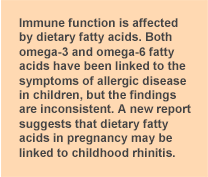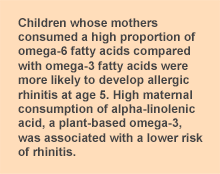
The search for ways to reduce the occurrence of childhood allergies has led to studies on how polyunsaturated fatty acids (PUFAs) might be involved. The huge increase in the consumption of vegetable oils, which supply large amounts of omega-6 PUFAs, has contributed to the reduced intake of omega-3 PUFAs, especially those from fish. The immune system is affected by fatty acids and several observational studies have reported a lower severity or delay of allergic symptoms in the offspring of mothers who consumed fish during pregnancy. Studies where mothers have consumed fish oil or long-chain omega-3 PUFAs during pregnancy have had mixed results in allergic symptoms of high-risk children. Some have observed decreases in childhood asthma and fewer positive skin prick tests for various allergens, while others have reported less occurrence or severity of eczema. Overall, the findings have been inconsistent, yet sufficiently encouraging to warrant further investigation.

The effect of high levels of omega-6 PUFAs, mainly linoleic acid, on allergic symptoms is generally considered detrimental. This is mainly because omega-6 fatty acids tend to promote the production of inflammatory substances, which contribute to disease symptoms. But here, too, results have been inconsistent. Higher levels of omega-6 PUFAs in maternal blood were associated with a higher risk of childhood rhinitis, but a lower risk of eczema. Others have observed no association with the proportions of omega-6 and omega-3 fatty acids in the mother’s blood, while a reduction in omega-6 PUFAs was linked to a significant reduction in asthma in 8-year-old children. A new observational study reported its findings from the study of the usual maternal diet during pregnancy and lactation and the child’s development of allergic disease at the age of 5. The report focused on the consumption of fat and fatty acids. None of the mother’s dietary fats or fatty acids was related to the occurrence of eczema or wheeze in the children. However, children whose mothers consumed a high proportion of omega-6 PUFAs compared with omega-3 PUFAs were more likely to develop allergic rhinitis, a finding that supports a previous report linking omega-6 PUFAs with a higher risk of rhinitis.

These investigators also observed that rhinitis occurred less frequently in infants whose mothers had high intakes of alpha-linolenic acid (ALA), the plant-based omega-3. A Japanese study reported a link between the mother’s consumption of alpha-linolenic acid and a lower risk of wheeze in the infants. The investigators in the present study also observed a lower risk of asthma in the infants of mothers with higher ALA intakes. Unfortunately, the study did not examine blood fatty acid levels and these might have provided additional insights. This study raises questions about the healthfulness of high intakes of omega-6 PUFAs and low omega-3 PUFAs for the risk of allergic rhinitis. It also points to the possible benefits of ALA in the risk of allergic rhinitis and possibly wheeze or asthma. No conclusions are possible from observational studies, but the study confirms that maternal fatty acid intakes influence the development of childhood allergies. Unfortunately, we are still far from knowing what an optimum pattern of food fatty acids during pregnancy might be.
 The search for ways to reduce the occurrence of childhood allergies has led to studies on how polyunsaturated fatty acids (PUFAs) might be involved. The huge increase in the consumption of vegetable oils, which supply large amounts of omega-6 PUFAs, has contributed to the reduced intake of omega-3 PUFAs, especially those from fish. The immune system is affected by fatty acids and several observational studies have reported a lower severity or delay of allergic symptoms in the offspring of mothers who consumed fish during pregnancy. Studies where mothers have consumed fish oil or long-chain omega-3 PUFAs during pregnancy have had mixed results in allergic symptoms of high-risk children. Some have observed decreases in childhood asthma and fewer positive skin prick tests for various allergens, while others have reported less occurrence or severity of eczema. Overall, the findings have been inconsistent, yet sufficiently encouraging to warrant further investigation.
The search for ways to reduce the occurrence of childhood allergies has led to studies on how polyunsaturated fatty acids (PUFAs) might be involved. The huge increase in the consumption of vegetable oils, which supply large amounts of omega-6 PUFAs, has contributed to the reduced intake of omega-3 PUFAs, especially those from fish. The immune system is affected by fatty acids and several observational studies have reported a lower severity or delay of allergic symptoms in the offspring of mothers who consumed fish during pregnancy. Studies where mothers have consumed fish oil or long-chain omega-3 PUFAs during pregnancy have had mixed results in allergic symptoms of high-risk children. Some have observed decreases in childhood asthma and fewer positive skin prick tests for various allergens, while others have reported less occurrence or severity of eczema. Overall, the findings have been inconsistent, yet sufficiently encouraging to warrant further investigation.  The effect of high levels of omega-6 PUFAs, mainly linoleic acid, on allergic symptoms is generally considered detrimental. This is mainly because omega-6 fatty acids tend to promote the production of inflammatory substances, which contribute to disease symptoms. But here, too, results have been inconsistent. Higher levels of omega-6 PUFAs in maternal blood were associated with a higher risk of childhood rhinitis, but a lower risk of eczema. Others have observed no association with the proportions of omega-6 and omega-3 fatty acids in the mother’s blood, while a reduction in omega-6 PUFAs was linked to a significant reduction in asthma in 8-year-old children. A new observational study reported its findings from the study of the usual maternal diet during pregnancy and lactation and the child’s development of allergic disease at the age of 5. The report focused on the consumption of fat and fatty acids. None of the mother’s dietary fats or fatty acids was related to the occurrence of eczema or wheeze in the children. However, children whose mothers consumed a high proportion of omega-6 PUFAs compared with omega-3 PUFAs were more likely to develop allergic rhinitis, a finding that supports a previous report linking omega-6 PUFAs with a higher risk of rhinitis.
The effect of high levels of omega-6 PUFAs, mainly linoleic acid, on allergic symptoms is generally considered detrimental. This is mainly because omega-6 fatty acids tend to promote the production of inflammatory substances, which contribute to disease symptoms. But here, too, results have been inconsistent. Higher levels of omega-6 PUFAs in maternal blood were associated with a higher risk of childhood rhinitis, but a lower risk of eczema. Others have observed no association with the proportions of omega-6 and omega-3 fatty acids in the mother’s blood, while a reduction in omega-6 PUFAs was linked to a significant reduction in asthma in 8-year-old children. A new observational study reported its findings from the study of the usual maternal diet during pregnancy and lactation and the child’s development of allergic disease at the age of 5. The report focused on the consumption of fat and fatty acids. None of the mother’s dietary fats or fatty acids was related to the occurrence of eczema or wheeze in the children. However, children whose mothers consumed a high proportion of omega-6 PUFAs compared with omega-3 PUFAs were more likely to develop allergic rhinitis, a finding that supports a previous report linking omega-6 PUFAs with a higher risk of rhinitis.  These investigators also observed that rhinitis occurred less frequently in infants whose mothers had high intakes of alpha-linolenic acid (ALA), the plant-based omega-3. A Japanese study reported a link between the mother’s consumption of alpha-linolenic acid and a lower risk of wheeze in the infants. The investigators in the present study also observed a lower risk of asthma in the infants of mothers with higher ALA intakes. Unfortunately, the study did not examine blood fatty acid levels and these might have provided additional insights. This study raises questions about the healthfulness of high intakes of omega-6 PUFAs and low omega-3 PUFAs for the risk of allergic rhinitis. It also points to the possible benefits of ALA in the risk of allergic rhinitis and possibly wheeze or asthma. No conclusions are possible from observational studies, but the study confirms that maternal fatty acid intakes influence the development of childhood allergies. Unfortunately, we are still far from knowing what an optimum pattern of food fatty acids during pregnancy might be.
These investigators also observed that rhinitis occurred less frequently in infants whose mothers had high intakes of alpha-linolenic acid (ALA), the plant-based omega-3. A Japanese study reported a link between the mother’s consumption of alpha-linolenic acid and a lower risk of wheeze in the infants. The investigators in the present study also observed a lower risk of asthma in the infants of mothers with higher ALA intakes. Unfortunately, the study did not examine blood fatty acid levels and these might have provided additional insights. This study raises questions about the healthfulness of high intakes of omega-6 PUFAs and low omega-3 PUFAs for the risk of allergic rhinitis. It also points to the possible benefits of ALA in the risk of allergic rhinitis and possibly wheeze or asthma. No conclusions are possible from observational studies, but the study confirms that maternal fatty acid intakes influence the development of childhood allergies. Unfortunately, we are still far from knowing what an optimum pattern of food fatty acids during pregnancy might be.

